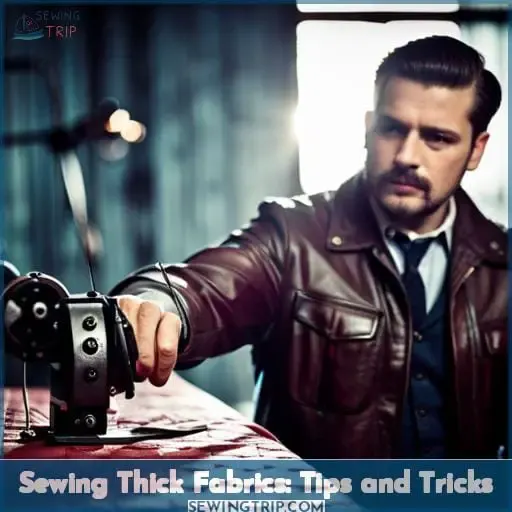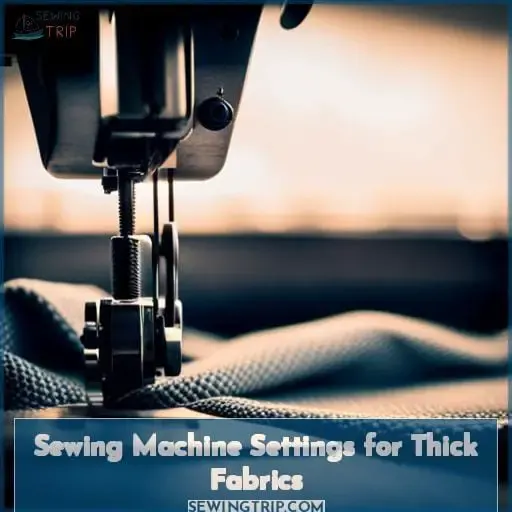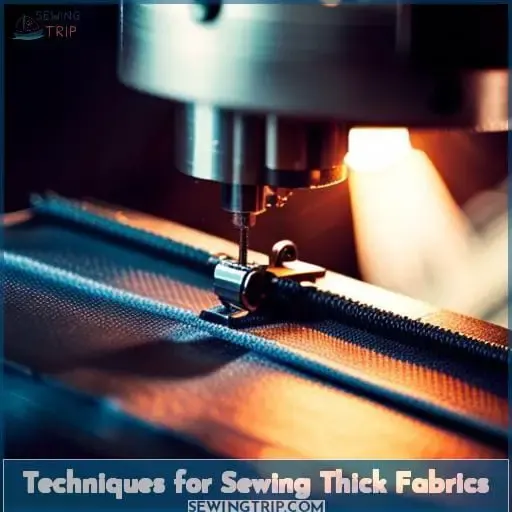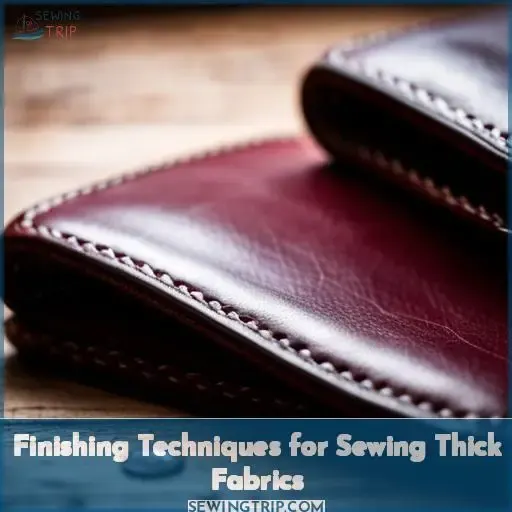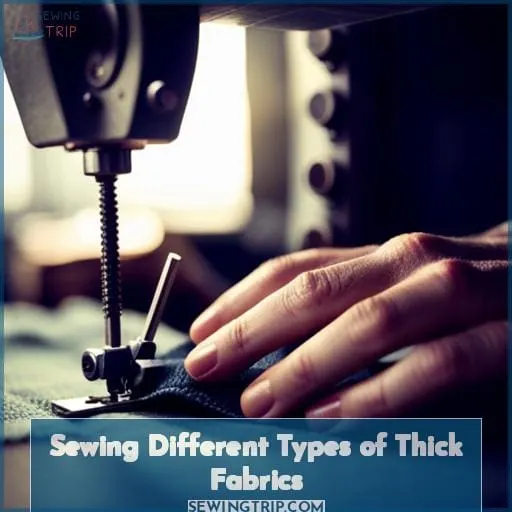This site is supported by our readers. We may earn a commission, at no cost to you, if you purchase through links.
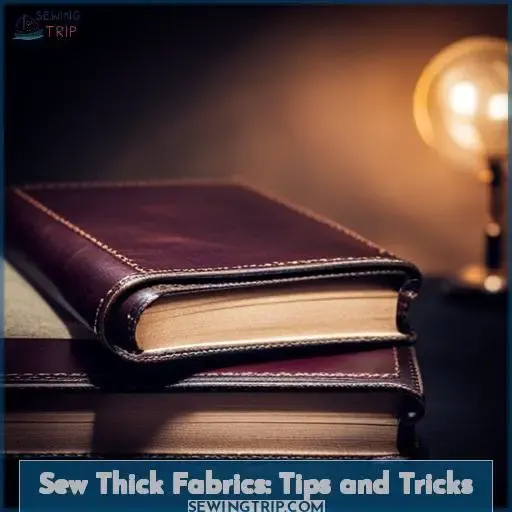 Are you ready to take your sewing skills up a notch and conquer thick fabrics like denim, leather, canvas, and wool? If so, then you are in the right place! Sewing with thicker materials can seem daunting at first, but don’t worry – it’s easier than it looks.
Are you ready to take your sewing skills up a notch and conquer thick fabrics like denim, leather, canvas, and wool? If so, then you are in the right place! Sewing with thicker materials can seem daunting at first, but don’t worry – it’s easier than it looks.
With the right preparation and tools along with some helpful tips and tricks for setting your machine correctly, as well as stitching techniques tailored specifically for these types of fabrics, anyone can learn how to sew something thick.
First, choose the right needle. You’ll want to use a sharp needle with a slightly larger size than usual. The thickness of fabrics like denim and canvas can bend and damage finer needles. Second, opt for the right thread. Sturdy thread meant for heavy fabrics works best to prevent breakage and uneven stitches.
Next, adjust the tension and presser foot pressure of your machine. More tension than normal is needed for thick seams that don’t pucker. Check your manual for how to increase tension. Also, increasing the foot pressure ensures the material moves smoothly under the foot without slipping.
When sewing, take it slow. Thicker fabrics have more resistance, so go at a steady pace to allow the machine to handle it. Use longer stitch lengths like 4 mm for more durability. It also helps to pin pieces together more frequently and use extra backstitching at seams.
Lastly, upgrade your tools if needed – walking feet, nonstick feet, and roller feet work wonders on heavy fabrics.
With the right preparations and some practice, you’ll be sewing thick materials with ease in no time.
Table Of Contents
- Key Takeaways
- Sewing Thick Fabrics: Tips and Tricks
- Sewing Machine Settings for Thick Fabrics
- Techniques for Sewing Thick Fabrics
- Overcoming Challenges With Home Sewing Machines
- Finishing Techniques for Sewing Thick Fabrics
- Sewing Different Types of Thick Fabrics
- Considerations for Upgrading to an Industrial Sewing Machine
- Conclusion
Key Takeaways
- Choose a sharp, slightly larger needle for thick fabrics. This will help the needle penetrate the fabric more easily.
- Use sturdy thread suitable for heavy fabrics. Thicker thread is less likely to break when sewing through multiple layers.
- Adjust machine tension and raise the presser foot when sewing thick fabrics. This provides more space for the fabric to move freely under the foot.
- Flatten bulky seams and use techniques to reduce bulk. Grading seams, trimming excess fabric, clipping curves, and notching seam allowances can help reduce thickness.
Sewing Thick Fabrics: Tips and Tricks
Sewing thick fabrics like denim, canvas, leather, and wool requires some special tools and preparation. Before embarking on any project with these thick materials, you’ll want to check your sewing machine‘s accessories, choose the appropriate needle, thread, and presser feet, and do some test stitches on scrap pieces.
It’s a good idea to use a new needle specifically designed for heavier fabrics – look for options like denim, topstitch, or leather needles. Sharp points and reinforced shafts will help penetrate the fabric. Thicker thread is also important so it doesn’t get pulled and break.
Avoid lightweight all-purpose thread and opt for quality polyester or cotton threads in the 30+ weight range. You may need a special presser foot as well, like a walking foot, rolled hem foot, or Teflon foot, to help feed the layers smoothly.
Always do test stitches first, especially if you are sewing multiple layers together. Check tension, stitch length, presser foot pressure, and make any necessary adjustments before starting on your actual project.
Be patient and go slowly to prevent frustration and mistakes. With the right preparation and tools, you can sew beautiful creations with any type of fabric.
Types of Thick Fabrics
You’ll encounter a variety of thick fabrics like denim, canvas, linen, leather, wool, and winter fabrics when you try sewing something substantial.
- Denim – Sturdy and prone to fraying. Use denim needles and polyester thread.
- Leather – Difficult to machine sew. Use leather needles and wax thread.
- Wool – Requires a press cloth. Use silk pins and steam.
- Canvas – Very stiff. Use silicone feet and polyester thread.
- Upholstery Fabric – Heavyweight. Use longer stitches and a walking foot.
With the right tools and techniques, you can master sewing thick fabrics at home.
Preparation and Tools
Check your sewing machine accessories and adjust the tension before sewing thick fabrics. Select the proper needle size for your fabric weight, like a size 100/16 for canvas or 110/18 for denim. Use a sharp, new needle to prevent skipped stitches. Choose a heavy duty thread like polyester or upholstery thread that can handle the texture.
Switch to a roller or walking presser foot to help feed thick layers smoothly. Test your stitch settings on a scrap piece, adjusting the length and width wider for denser fabrics.
With the right preparation and tools, you’ll gain confidence sewing all types of fabrics, even the thickest of leathers and wool.
Sewing Machine Settings for Thick Fabrics
When working with heavier fabrics like denim or leather on your home sewing machine, start by choosing the right needle and thread. Invest in sharp needles with larger sizes, like 110/18, and pair them with heavy duty threads, like polyester upholstery thread, to avoid skipped stitches and breakage.
You’ll also want to swap out your regular presser foot for a specialty foot, like a roller or walking foot, to feed the thick layers smoothly.
Needle and Thread
Sharpen your sewing needle like a warrior readying an arrow for piercing thick hides. Select heavier threads like polyester or topstitching to punch through the dense fibers. Size 18 needles glide smoothly without fraying delicate threads. Tugging indicates too loose a tension; puckering shouts a tension too taut.
Condition wiry threads with beeswax so they feed smoothly. Clip wayward fibers with scissors honed to a razor’s edge. Adjust longer stitch lengths to straddle the chasm between fabric layers. Your machine must not falter when facing the test of thickness.
Presser Feet
Try a specialty presser foot when sewing thick fabrics. With thick fabrics, you’ll want a foot that glides smoothly over the layers.
- The walking foot prevents shifting between fabric layers.
- The roller foot rolls over thick seams smoothly.
- Use a Teflon foot to prevent sticking when sewing slippery fabrics like leather.
- An open toe foot improves visibility.
- A spring action foot helps feed the fabric through the machine.
Test different presser feet with scraps to see which one helps your machine handle the thickness best. The right specialty foot can make all the difference in keeping the sewing moving fluidly.
Techniques for Sewing Thick Fabrics
When working with thick fabrics on your home sewing machine, immediately adjust the stitch length and tension. Start by testing different stitch lengths on a scrap piece, usually around 3.5-4.5mm works well for heavier fabrics. Then, check the tension and make sure the presser foot lift is raised high enough to accommodate the thickness.
Choosing the Right Stitch Length
Determine the ideal stitch length for thick fabrics to prevent skipped stitches. Use a longer stitch length between 3 to 4 mm when sewing fabrics like denim, canvas, or upholstery. A longer stitch length allows the feed dogs to grip and advance the multiple layers smoothly under the presser foot.
Test different stitch lengths on scrap material first to find the optimal setting – too long may cause a loose stitch while too short leads to thread jams. Adjust the stitch length dial on your machine and remember to reset it when sewing lighter fabrics again.
Finding the right stitch length prevents frustration and broken needles when sewing heavy projects.
Adjusting Tension and Lift
Raise your presser foot as high as it’ll go when sewing thick fabrics. Otherwise, the weight can make it difficult to feed material through. This extra lift prevents fabric from getting stuck. Adjust the tension down slightly too, around 3-5, so the bobbin thread doesn’t get pulled up on the underside.
For heavy projects, use thicker needles and specialty presser feet to glide layers smoothly. If adjusting your home sewing machine still struggles, it may be time to try an industrial model capable of powering through the thickest materials without hesitation.
Overcoming Challenges With Home Sewing Machines
When working with thicker fabrics on a home sewing machine, choose simpler projects with fewer layers to avoid frustrating jamming and broken needles. To flatten bulky seams, keep handy tools like a steam iron, tailor’s clapper, or rubber mallet on hand to gently pound the layers smooth.
Varying the stitch length can also help sew through thick seams more easily. For tough materials like denim or canvas, a special denim needle often prevents skipped stitches. While home sewing machines may occasionally struggle with heavy fabrics, taking preventative steps allows completing beautiful garments without frustration.
Choosing Suitable Projects
Consider choosing simpler projects with fewer layers when working with thick fabrics on a home sewing machine. When initially gaining experience with heavier materials, opt for basic creations like tote bags, pillow covers, or even a simple skirt.
Avoid intricate designs requiring precise construction, at least until you become comfortable manipulating and guiding multiple fabric layers through the machine.
Prioritize working with medium-weight denim, canvas or upholstery fabric over extremely bulky leather or wool coats to start. Compatible fabrics will behave better, helping perfect your stitching technique before undertaking more complex endeavors.
With practice guiding fabric, adjusting tension, choosing proper needles and thread, and handling multiple layers, you’ll be able to tackle any project imaginable in no time.
Using Steam, Hammer, or Tailor’s Clapper
You’ll find a steam iron, tailor’s hammer, or clapper handy for flattening thick seams as you sew. Steam softens the fibers for easier pressing. Regularly test steam on scraps, and be cautious with delicate fabrics.
When pressing, hover over layers without touching down. Alternatively, a tailor’s clapper sandwiches the fabric and applies instant pressure. Slide the clapper in deep seam allowances to flatten bulky areas. Lastly, a rubber mallet taps areas that need flattening.
Gently tap along the seam line or hem, working from the widest part to the edge. Let the mallet do the work for you instead of excessive ironing. Proper pressing makes all the difference when working with thick fabrics.
Finishing Techniques for Sewing Thick Fabrics
Your home sewing machine has limits when sewing thick fabrics. Trimming seam allowances and grading seams helps reduce bulk for a neater finish.
Reducing Bulk
Reduce bulk using French seams or bias binding edges. Here are 4 ways to reduce bulk when sewing thick fabrics:
- Grade seams by trimming the seam allowance of one seam to reduce thickness.
- Finish edges with single or double fold bias tape for neatness without adding bulk.
- Construct French seams with the seam allowance enclosed inside to minimize bulk.
- Finish hems wider than on regular fabrics, spreading out bulk over a larger area. Proper pressing technique with steam also helps reduce thickness in seams and hems.
Using Wide Hems
Your fluorescent veil gracefully dances over the turquoise flagstones as you stroll through the royal gardens, the ample width keeping your steps light and easy. When working with heavy fabrics like denim or wool, wide hems are your friend. They prevent heaviness along the edge and make garments more comfortable to wear.
Choosing widths like 2-3 inches allows thick seams to lie flat. Take care when stitching wide hems – use clips, not pins, for better control. Hand baste first if needed. For straight hems, a dual feed foot prevents tunneling.
Proper Pressing Techniques
Remembering proper iron usage becomes pivotal when handling thick fabrics. Press your seams immediately after stitching. Use a steam iron and your pressing cloth to apply that crucial heat. Wool and other delicates require a lower setting.
Don’t push or pull the iron across the surface. Simply lift and lower vertically with care. For leather and vinyl, a sheet of parchment paper can substitute for the cloth. Allow projects to cool fully before moving and enjoy even presses with consistent technique.
Sewing Different Types of Thick Fabrics
Hi there! You’ve clearly got experience working with all sorts of fabrics, from lightweight cottons to heavy denim and leather. Let’s talk specifics about sewing thicker materials such as denim, canvas, linen, as well as leather, wool, and heavyweight winter fabrics.
Thicker fabrics like denim, canvas, and linen can be more challenging to work with than lighter weight cottons. When sewing these thicker, heavier fabrics, it’s important to use the appropriate needle size.
A sharp needle will pierce the fabric cleanly. You’ll want to use a denim or topstitch needle. These have a sharper point and stronger shaft. When working with heavy canvas, you may need a leather needle, as it has a specialized tip and triangular point to cut through the thick woven fibers.
Adjust your machine’s settings too. Set your stitch length slightly longer, around 3-4 mm, to allow the thicker thread to feed through easily without breaking. A longer stitch length also prevents big gaps between stitches that can cause seams to rip.
Engage your machine’s heavy duty feature or reduce the presser foot pressure so that the fabric can move easily underneath. Go slowly and don’t pull or stretch the fabric as you sew. Let the machine do the work! When finishing seams on heavy fabrics, consider using flat-felled seams or French seams.
These provide durability and eliminate bulky enclosed seam allowances. Thicker threads, like topstitching thread, help create visible, long-lasting seams on heavier fabrics as well.
Denim, Canvas, and Linen
Hug the curves of denim as you guide it through your machine. As the deluxe foot glides over blue heaven, experiment with varied stitch length to add dimension. When the bulk of multiple canvas layers resists the presser foot, engage your core muscles to gently hand crank the wheel.
Hug each corner of the linen, shaping it with nimble fingers before tackling those double turned hems. Make the most of the canvas’s structure when choosing flat felled seams or clean French seams to minimize bulk.
Distress denim with fray check and bias tape for folksy upcycled projects like an ottoman cover. Play with stitches and seams to create personalized masterpieces, thick fabrics bending to your will.
Leather, Wool, and Winter Fabrics
Experiment with different needles, threads, interfacing, and stitch types when sewing thicker materials. Proper preparation and care allow you to create unique leather crafts, woolen accessories, and stylish winter fashions on your home machine.
Considerations for Upgrading to an Industrial Sewing Machine
Ready to feel like a pro by upgrading your sewing skills for thick fabrics? Purchasing an industrial sewing machine can empower you to tackle tricky upholstery and denim projects with power and precision.
Let’s discuss some key benefits to weigh before investing in one of these workhorse machines.
Benefits of industrial machines
You’ll find industrial machines excel at sewing thick fabrics effortlessly. Their sturdy steel frames and powerful motors easily handle multiple layers of denim or canvas with precision. The walking foot and roller foot glide smoothly over seams, while heavy-duty needles pierce fabric with ease.
Built for efficiency, these workhorses churn out miles of perfectly straight stitching without hesitation. Their precise engineering and adjustable features allow you to customize settings flawlessly for any project.
With an industrial machine, you’ll sail through upholstery or heavy outerwear pieces with precision and ease.
Factors to consider
You’d do well to ensure the machine has enough power, speed, and workspace for sewing your thick fabrics before making the investment. Gauge the thickness of the materials you typically work with. Test heavier fabrics on an industrial machine first to see if it can handle multiple layers without straining.
Consider if an industrial machine will allow you more seam options and flexibility for working with different material thicknesses and weights. Carefully evaluate whether upgrading is truly necessary for your projects or if adjustments to your current machine could expand its abilities.
Upgrading considerations
Measure the thickness of your project and match it to an industrial machine’s abilities before committing to an upgrade. Upgrading your home sewing machine opens up new possibilities, but consider your sewing needs first.
- Evaluate the size of your project, number of layers, and fabric thickness.
- Research machines with higher lift, more power, and specialty presser feet.
- Prioritize must-have features like maintenance needs, noise level, and size of the machine.
Before investing in an industrial machine, closely examine your sewing habits. Will the upgrade truly enhance your experience or just sit around collecting dust? Choose thoughtfully to avoid buyer’s regret.
Conclusion
Sewing thick fabrics takes dedication, skill, and experience. Like a sculptor carving a masterpiece, you must have the right tools and techniques to create something beautiful. With the right preparation, patience, and practice, you can sew something thick with confidence.
From denim and canvas to leather and wool, your sewing machine can handle the challenge with the right settings and techniques.
From adjusting stitch size and tension to reducing bulk and pressing with care, you can create masterpieces with thick fabrics that’ll last for years.

